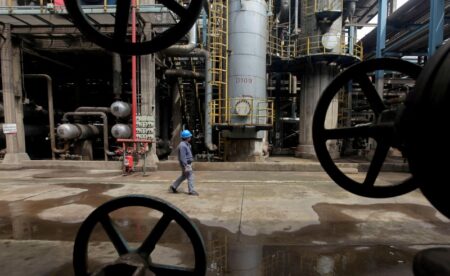By Tom Westbrook
SINGAPORE (Reuters) -Chinese shares slumped and commodities were struggling to find a footing on Wednesday as investors tempered expectations for a robust Chinese economic recovery, while a downbeat outlook from New Zealand’s central bank sent the to a seven-week low.
The and blue-chip CSI300 nursed losses of around 4% in afternoon trade, paring much larger falls when the finance ministry called a press conference on fiscal policy and raised expectations of stimulus.
Hong Kong’s bounced to flat and the Australian dollar shed losses.
China’s surging markets had turned suddenly fragile and commodities from oil to metals fell on Tuesday when a news conference from China’s National Development and Reform Commission yielded no major new stimulus details.
“To be fair only the Ministry of Finance or State Council can adjust the budget,” said Nick Ferres, chief investment officer at Vantage Point Asset Management, as focus shifted to the Oct. 12 announcement and Monday’s market reaction.
Markets are looking for a spending package between 2 and 10 trillion yuan ($280 billion to $1.4 trillion) and Ferres said his sense was that support needs to be on top of previous commitments and boost GDP by about 2 percentage points to be helpful.
Dalian iron ore and Shanghai pared losses in the afternoon but were still in the red. futures, which fell 4.6% overnight, steadied at $77.88 a barrel.
rose 1%, with shares in convenience store Seven & I Holdings leaping after Bloomberg News reported Canadian retailer Alimentation Couche-Tard would raise its buyout offer.
PATIENCE
Traders have so far regarded China’s stocks slide as an overdue pullback after a hefty 25% surge in the previous six sessions.
Still, the drops leave mainland stocks on course for their largest losses since April 2022, when pandemic lockdowns were in force in major cities.
Just about every sector was down in China, though property and tourism were heavily beaten-down in a sign of some doubts that state support will be large and swift enough to turn around consumers’ confidence.
“We think markets can still re-rate up from here, but policymakers will need to start showing their cards or investors will lose patience over how the broader domestic economy, especially consumption, can recover,” said Eugene Hsiao, head of China equity strategy at Macquarie Capital.
“The other variable remains macro, as the PBOC’s monetary policy could be more handcuffed if Fed rate cuts do not materialise as quickly as planned,” he said.
Market expectations of Federal Reserve rate cuts have been pared back following strong labour market data last week, lifting yields and the dollar which was the backdrop to a 0.9% slide for the New Zealand dollar in the Asia session.
The kiwi fell through its 200-day moving average to a seven-week low after the central bank cut interest rates by 50 basis points and left the door open to more.
“We expect another 50bps cut in November. The Kiwi economy needs it,” said Kiwi Bank chief economist Jarrod Kerr.
The dollar also rose slightly to 148.525 yen and $1.0971 per euro.
Treasuries steadied following recent selling, leaving U.S. two-year yields at 3.96% and 10-year yields at 4.01%.
Minutes from the Fed’s September meeting – where U.S. rates were cut 50 bps – are due later in the session, along with appearances from the Fed’s Raphael Bostic, Lorie Logan and Mary Daly.
($1 = 7.0560 renminbi)
Read the full article here
















